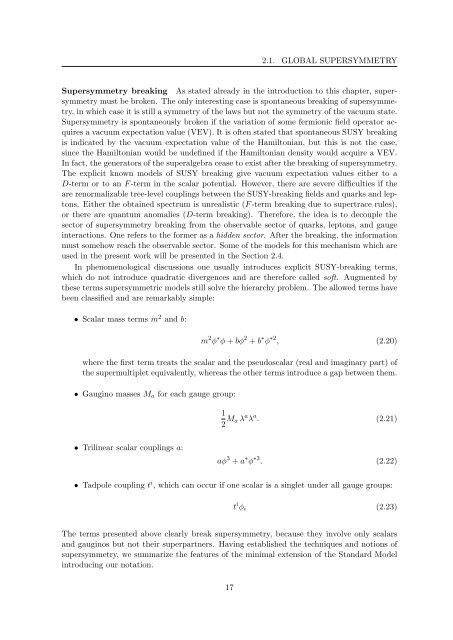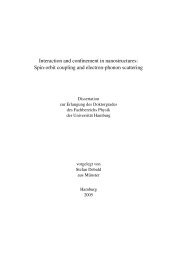Gravitinos and hidden Supersymmetry at the LHC - Universität ...
Gravitinos and hidden Supersymmetry at the LHC - Universität ...
Gravitinos and hidden Supersymmetry at the LHC - Universität ...
Create successful ePaper yourself
Turn your PDF publications into a flip-book with our unique Google optimized e-Paper software.
2.1. GLOBAL SUPERSYMMETRY<br />
<strong>Supersymmetry</strong> breaking As st<strong>at</strong>ed already in <strong>the</strong> introduction to this chapter, supersymmetry<br />
must be broken. The only interesting case is spontaneous breaking of supersymmetry,<br />
in which case it is still a symmetry of <strong>the</strong> laws but not <strong>the</strong> symmetry of <strong>the</strong> vacuum st<strong>at</strong>e.<br />
<strong>Supersymmetry</strong> is spontaneously broken if <strong>the</strong> vari<strong>at</strong>ion of some fermionic field oper<strong>at</strong>or acquires<br />
a vacuum expect<strong>at</strong>ion value (VEV). It is often st<strong>at</strong>ed th<strong>at</strong> spontaneous SUSY breaking<br />
is indic<strong>at</strong>ed by <strong>the</strong> vacuum expect<strong>at</strong>ion value of <strong>the</strong> Hamiltonian, but this is not <strong>the</strong> case,<br />
since <strong>the</strong> Hamiltonian would be undefined if <strong>the</strong> Hamiltonian density would acquire a VEV.<br />
In fact, <strong>the</strong> gener<strong>at</strong>ors of <strong>the</strong> superalgebra cease to exist after <strong>the</strong> breaking of supersymmetry.<br />
The explicit known models of SUSY breaking give vacuum expect<strong>at</strong>ion values ei<strong>the</strong>r to a<br />
D-term or to an F -term in <strong>the</strong> scalar potential. However, <strong>the</strong>re are severe difficulties if <strong>the</strong><br />
are renormalizable tree-level couplings between <strong>the</strong> SUSY-breaking fields <strong>and</strong> quarks <strong>and</strong> leptons.<br />
Ei<strong>the</strong>r <strong>the</strong> obtained spectrum is unrealistic (F -term breaking due to supertrace rules),<br />
or <strong>the</strong>re are quantum anomalies (D-term breaking). Therefore, <strong>the</strong> idea is to decouple <strong>the</strong><br />
sector of supersymmetry breaking from <strong>the</strong> observable sector of quarks, leptons, <strong>and</strong> gauge<br />
interactions. One refers to <strong>the</strong> former as a <strong>hidden</strong> sector. After <strong>the</strong> breaking, <strong>the</strong> inform<strong>at</strong>ion<br />
must somehow reach <strong>the</strong> observable sector. Some of <strong>the</strong> models for this mechanism which are<br />
used in <strong>the</strong> present work will be presented in <strong>the</strong> Section 2.4.<br />
In phenomenological discussions one usually introduces explicit SUSY-breaking terms,<br />
which do not introduce quadr<strong>at</strong>ic divergences <strong>and</strong> are <strong>the</strong>refore called soft. Augmented by<br />
<strong>the</strong>se terms supersymmetric models still solve <strong>the</strong> hierarchy problem. The allowed terms have<br />
been classified <strong>and</strong> are remarkably simple:<br />
• Scalar mass terms m 2 <strong>and</strong> b:<br />
m 2 φ ∗ φ + bφ 2 + b ∗ φ ∗2 , (2.20)<br />
where <strong>the</strong> first term tre<strong>at</strong>s <strong>the</strong> scalar <strong>and</strong> <strong>the</strong> pseudoscalar (real <strong>and</strong> imaginary part) of<br />
<strong>the</strong> supermultiplet equivalently, whereas <strong>the</strong> o<strong>the</strong>r terms introduce a gap between <strong>the</strong>m.<br />
• Gaugino masses M a for each gauge group:<br />
1<br />
2 M a λ a λ a . (2.21)<br />
• Trilinear scalar couplings a:<br />
aφ 3 + a ∗ φ ∗3 . (2.22)<br />
• Tadpole coupling t i , which can occur if one scalar is a singlet under all gauge groups:<br />
t i φ i (2.23)<br />
The terms presented above clearly break supersymmetry, because <strong>the</strong>y involve only scalars<br />
<strong>and</strong> gauginos but not <strong>the</strong>ir superpartners. Having established <strong>the</strong> techniques <strong>and</strong> notions of<br />
supersymmetry, we summarize <strong>the</strong> fe<strong>at</strong>ures of <strong>the</strong> minimal extension of <strong>the</strong> St<strong>and</strong>ard Model<br />
introducing our not<strong>at</strong>ion.<br />
17

















